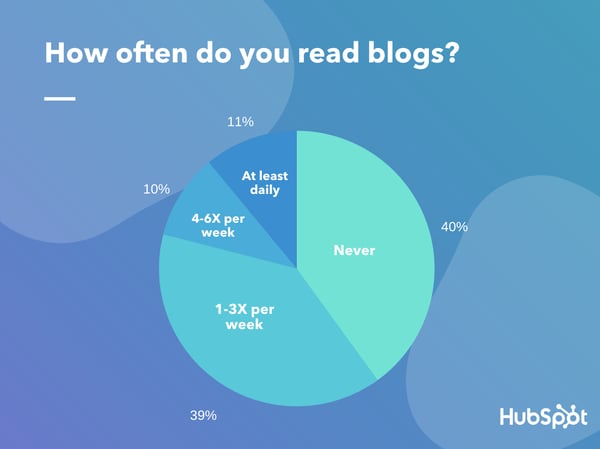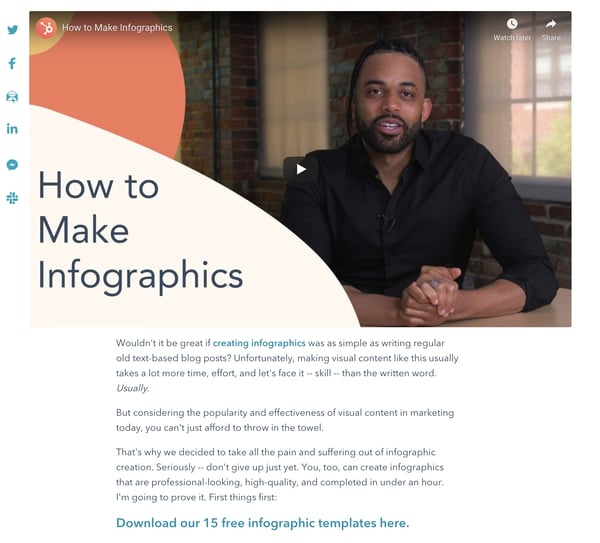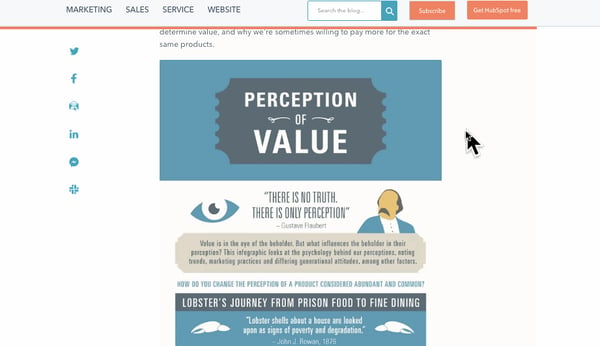How To Blog In Weebly Read More
According to our 2020 State of Marketing report, blogging is the third most utilized form of content marketing, just behind video and infographics. Like any successful strategy, many brands, publishers, and individuals have jumped on the blogging bandwagon. Currently, there are 600 million active blogs globally. Meanwhile, the number of active U.S. bloggers rose from 22 million to 32 million between 2014 and 2020. "Despite the numbers that show the enduring impact blogs can have on business, the perception of blogging as a valuable content marketing channel is continually called into question: the phrase 'is blogging dead?' has 26.8 million results on Google. To determine where blog readership might stand today, I surveyed 400 people about how often they read blogs. As a blogger who constantly writes, discovers and reads blogs online regularly, I was expecting that a large number of people would say that they read blogs at least daily. However, after I performed the Lucid survey, I found the end results surprising -- and a little unnerving. When I asked participants, "How often do you read blogs?", a whopping 40% of them said, "Never." Data Source; Lucid Before you go deleting your blog just because of one survey -- remain calm. While 40% of people in this survey say they never read blogs, other research suggests that nearly 80% of internet users interact with them regularly. It's also important to note that some people might not even be realizing how often they're actually reading a blog. For example, people might not seek out a blog to answer their questions, but a page they discover with helpful information on it after a search query might be a blog. Additionally, people that follow a blog or company might read blog posts on their corporate site, but could still just think of them as "articles" or "company announcements." Not to mention, blogging is still incredibly valuable for search engine optimization. In fact, having a blog on your website can result in a 434% increase in indexed pages and a 97% increase in indexed links. Although I was a bit concerned by the number of people that claim they "never" read blogs, this content strategy still seems to be effective. While 40% of the group claims they don't read blogs, 60% say they read them more than once weekly. One-third of this group even reads blogs four to six times a week or more. In short, you should definitely still be blogging. Lastly, it's important to keep in mind that this survey was a random sampling of consumers from all industries and age groups. While people in some demographics might have less need for reading blogs, people in industries like marketing or B2B might rely on them to stay up to date in their industry. While you should take the results above with a grain of salt, the percentage of people who never read blogs is still worth noting. This large percentage shows how blog-based marketing might still run into barriers. This could also be part of the reason why it's fallen from the top to third-most-common content marketing tactic in past years. Yes. Less innovative blog content won't cut it anymore. But, when you think strategically about your blog, the overall tactic is still highly effective. The HubSpot Blog that you're on right now is living proof. If you're a small to medium business marketer, these results shouldn't deter you from starting a blog. Instead, they should make you realize that you'll need to get creative to build a competitive blog that generates traffic and leads. To help you grab attention from large audiences -- even if they less frequently read blogs -- here are five ways to innovate on your blog strategy. One of blogging's biggest competitors is video content marketing -- a.k.a. the top content marketing strategy according to .... But, if you don't have time to test a full video strategy, you can consider posting a few blog posts with videos on your blog instead. On the HubSpot Blog, we regularly add videos to our own blog posts in order to give more in-depth detail or expert tips on the topic we've written about. This way, readers who find the blog post can either read or watch the content. Here's one example of a blog post where we included a video related to its topic: On top of improving the user's experience, placing videos on your blog can also make web content rank in video-based search results. Additionally, video content can also be incredibly engaging when you share them on your social media channels. If you're thinking that creating videos will be too expensive or technical for your business, there are strategies you can use to produce videos on a budget. This step-by-step guide walks you through how to brainstorm, script, and affordably shoot videos for your blog or other platforms even when you aren't working with a big budget. In the first few years of my career, when I worked as an editor in newsrooms and small startups, I designed a number of page layouts and basic web graphics. Now, I often create charts and graphs for my blog posts -- including the one you see in the intro above. But, interestingly enough, I've only ever taken one formal course in graphic design. The truth is, with all the technology and design-related apps we have today, creating basic graphics isn't impossible, hard, or time-consuming. In fact, while working on a tight deadline, I used Canva to create the chart seen in the introduction in under five minutes. If you hire a graphic designer or get the hang of creating graphics quickly, you can also test out posting infographics as the centerpoint of your blog posts. Here's a post where the HubSpot Blog did just that: While it might take a little bit longer to create branded designs and templates for your blog at first, these visuals will be incredibly helpful for gaining image search traffic. Like video content, original images can also be highly shareable and engaging on social media. Some bloggers think that they can get away with writing short. Light-lift blog posts between 200 to 300 words. While tiny, low-effort posts might get some search traffic, they're not going to make your content feel original or interesting to the reader. To compete with more experienced blog sites, write in-depth posts that include data and facts to back up each point that you discuss. If you can, leverage data collection platforms like online survey platforms to collect original data that you can then post on your blog. This will make your content look more credible and trustworthy, but it also can boost search traffic. Here's how: When you include your own data in blog posts, other bloggers or journalists looking for data to back up their points might link to your blog posts as evidence. These links are often called "backlinks." While getting mentioned on other websites certainly boosts brand awareness, backlinks also improve your authority in search engines. Like data, original quotes also encourage backlinking. Aside from this benefit, blog posts with quotes or expert insights from industry thought leaders might be shareable or engaging on social media platforms like LinkedIn. While many of the tips above will help you boost your non-organic traffic as well as the reader's experience, you should also pay attention to organic traffic -- which will likely account for most of your views. Aside from videos, visuals, and encouraging backlinks with original information, you can also improve organic traffic by leveraging keyword research and other SEO strategies. If you're new to SEO, or search engine optimization, it's actually not that hard to get up to speed on these strategies. While some tactics are as simple as adding alternative text to your images, others include internal linking related blog posts to a new piece you're publishing. To get up to speed on a few easy and effective SEO tactics, check out this blog post. Although SEO will likely be a primary source of traffic for you, you'll still want to make sure you promote blog posts on social media channels. Why? While it will take time for blog posts to rank in search result pages, you can share your content on social media, email, or other channels to gain non-organic traffic immediately after you publish a post. Lastly, promoting any content from your website effectively boosts brand awareness. By posting valuable blogs on your channels, you could gain more followers, post shares, and engagements from audiences that you didn't have before building a social media strategy. As 2020 continues, we're going to see even more bloggers take on competitive strategies that embrace new content formats in order to gain audiences and prevent low readership. Regardless of which tactics you decide to test out, keep these things in mind: To get more insider tips on how to be an effective blogger, check out this post with insights directly from the HubSpot Blog team. 

5 Ways to Combat Low Blog Readership
1. Experiment with video and text in your posts.

2. Add infographics or other original images to your content.

3. Publish original data, quotes, and expert insights.
4. Use SEO strategies to build traffic and rank on search pages.
5. Promote your content on the right platforms.
Building a Better Blog


Originally published Mar 23, 2020 7:00:00 AM, updated March 26 2020
How To Blog In Weebly Read More
Source: https://blog.hubspot.com/marketing/do-people-read-blogs
Posted by: pearsoncoight.blogspot.com

0 Response to "How To Blog In Weebly Read More"
Post a Comment